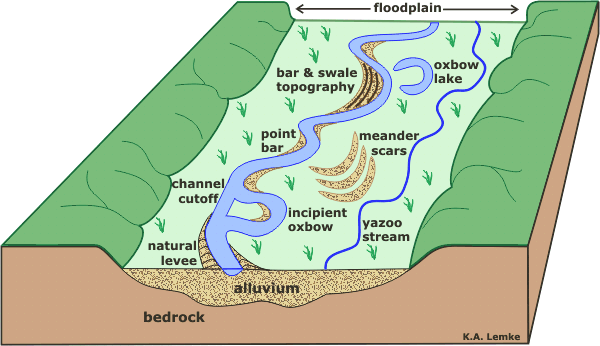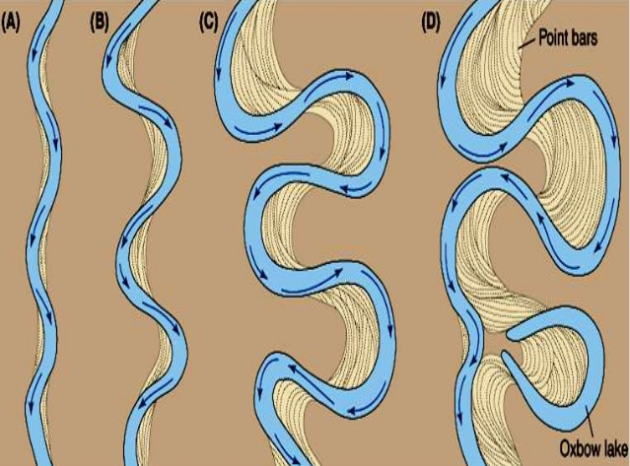Throughout floodings, the flood waters down payment fine-grained sediment into the oxbow lake. Therefore, oxbow lakes have a tendency to become filled out with fine-grained, organic-rich sediments with time. Throughout low flow problems, straight river channels have bars of sediment on their beds. The flowing water weaves around these bars of sediment which consequently produces much deeper pathways where most of the water streams called pools and superficial locations where much less water flows called riffles. Inevitably, the river flow starts to turn back and forth.
Keep in mind that on the shallower within the bend sediment can build up to create a slip off incline, whereas on the deeper outside of the bend where the current is faster and also disintegration runs, a river high cliff forms. As the river acquires extra velocity, the water is pushed to the outside of the river causing more erosion on the outside bend, which creates a steep river cliff. This is attained with processes like hydraulic activity as well as abrasion. Water on the inside of the bend of the river has a lower velocity since there is more friction. For that reason, the water starts to deposit wore down products like sand and tile, subsequently developing a slip off incline.
River Landforms
As a cloud’s water beads or ice crystals grow larger, gravity tugs them to Earth in the type of rain and snow. And water makes its back to the seas, in pouring rivers. But hill streams are confined by the steep-walled valleys they carve. As even more of the stream’s circulation is drawn away right into the strengthening hole on one financial institution as well as away from the opposite of the network, the circulation there deteriorates as well as slows. I bear in mind reading about an experiment where a person ran thin down a likely sheet of glass, and the stream formed meanders just from rubbing with the glass. For that reason, also if you would certainly start with a straight canal, some parts of the wall surfaces are preferentially worn down over others, triggering the canal to no more be right.
- ” One of the vital consequences of helical flow in meanders is that debris deteriorated from the beyond a meander bend tends to be moved to the inner bank or factor bar of the next downstream bend.”
On the contrary side of the channel where the velocity is lower product is deposited. The photo listed below shows evidence of undercutting on the external bank and deposition on the inner financial institution of the meander. They are located outside of a stream bend, opposite theslip-off slopeon the within the bend. Their shape resembles a smallcliff, and also are formed by the disintegration of soil as the stream collides with the river bank. Instead of apoint bar, which is a location ofdeposition, a cut bank is an area oferosion.
What System Triggers Rivers To Meander Or Contour?
When a meander gets removed from the major stream body, an oxbow lake is formed. A cut bank is a frequently upright bank or cliff that creates where the outside, concave financial institution of a meander reduces right into the floodplain or valley wall of a river or stream. A cutbank is also understood either as a river-cut high cliff, river high cliff, or a bluff and also spelled as cutbank. Disintegration that forms a cut financial institution happens at the outside financial institution of a meander because helicoidal flow of water keeps the financial institution washed clean of loosened sand, silt, and debris and also subjects it to constant erosion. Because of this, the meander deteriorates as well as moves in the direction of the outside bend, developing the cut financial institution.
The waveform depends eventually on the features of the flow yet the specifications are independent of it as well as evidently are triggered by geologic aspects. In general the meander length is 10– 14 times, with a typical 11 times, the fullbank network size as well as 3 to 5 times, with an average of 4.7 times, the distance of curvature at the apex. River landforms can be divided into top, center and also lower program features. As the river relocates from the upper course to the reduced course, the functions in the river will certainly transform.
5 3 Unfavorable And Also Positive Twists
As such, early use of the term, from the late 1500s, referred to intricate and also windy speech and also ideas, along with the geomorphological feature. The river in Turkey is called Menderes River, south of Izmir, near the ancient Greek town of Miletos. After several floods there are a number of layers of sediment deep on the flood level. The area over which they flooding is known as the floodplain and this usually coincides with regions where meanders kind. Within the river itself, thefastest existing is found on the outside of a bend and also the slowest present on the inside of the bend, this can be observed on layout A.
As a result, twists are developed as a river goes around a bend in which a lot of the moving water is pushed in the direction of the outdoors section of the water flow. The speed of water flow increases as well as the hydraulic activity together with abrasion pressures influenced lead to boosted erosion. Sometimes an incised, likewise called established, meander is removed. They are developed when a river erodes via the slim neck of land in between the ends of a loophole, leaving the loop without an active cutting stream. One dramatic rincon on Lake Powell is called “The Rincon.” In instance of an entrenched river, a slip-off slope is a gently sloping bedrock surface that climbs from the within, concave bank of an asymmetrically established river.
Just How Does A Waterfall Form?
The thalweg hugs the outer banks as well as go back to facility over the riffles. The meander arc length is the range along the thalweg over one meander. Disintegration, transport and also deposition are all processes that produce the characteristic attributes of meanders displayed in the images over. There are numerous stages associated with the production of meanders. The meander pattern is common; it’s hard to locate instances of straight streams of excellent size and, even then, the deepest part of the network– the thalweg– will meander within the straight network.
They are predictable challenges that instigate meander formation by deflecting the stream. As an example, the stream might be assisted right into a geological fault. The line of maximum depth, or channel, is the thalweg or thalweg line. It is usually designated the borderline when rivers are used as political boundaries.